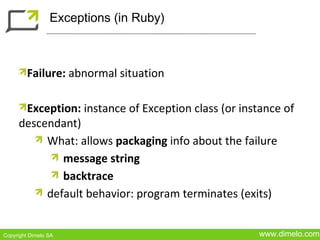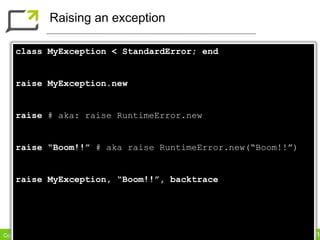Exceptions in Ruby - Tips and Tricks
- 1. Exceptions in Ruby Tips & Tricks Vlad ZLOTEANU #ParisRB July 3, 2002 Software Engineer @ Dimelo @vladzloteanu Copyright Dimelo SA www.dimelo.com
- 2. About me R&D Software Engineer @ Dimelo @vladzloteanu https://github.com/vladzloteanu Copyright Dimelo SA www.dimelo.com
- 3. Exceptions (in Ruby) Failure: abnormal situation Exception: instance of Exception class (or instance of descendant) What: allows packaging info about the failure message string backtrace default behavior: program terminates (exits) Copyright Dimelo SA www.dimelo.com
- 4. Exceptions classes in Ruby Exception NoMemoryError ScriptError LoadError SignalException Interrupt StandardError ArgumentError IOError ... RuntimeError SystemExit Copyright Dimelo SA www.dimelo.com
- 5. Raising an exception class MyException < StandardError; end raise MyException.new raise # aka: raise RuntimeError.new raise “Boom!!” # aka raise RuntimeError.new(“Boom!!”) raise MyException, “Boom!!”, backtrace Copyright Dimelo SA www.dimelo.com
- 6. Rescuing exceptions begin raise MyError.new("Booooom!") rescue MyError puts "MyError just hapened" rescue # Will rescue StandardError puts "a RuntimeError just happened" rescue Exception => e puts ”Exception: #{e.message}” e.backtrace.each{|line| puts “ > #{line}”} end Copyright Dimelo SA www.dimelo.com
- 7. Intermezzo: Signals Signals – used to alert threads/processes (hardware faults, timer expiration, terminal activity, kill command, etc) SIGINT: CTRL+C in terminal (can be caught) SIGTERM: Sent by kill command by default (can be caught) SIGKILL: Uncatchable exception (kill -9) A SignalException is raised when a signal is received Copyright Dimelo SA www.dimelo.com
- 8. What should we rescue? Copyright Dimelo SA www.dimelo.com
- 9. Rescuing exceptions TIP: DON’T RESCUE ‘EXCEPTION’ class! begin while(true) ; end rescue Exception puts "Rescued exception; Will retry" retry end ^CRescued exception; WIll retry ^CRescued exception; WIll retry ^CRescued exception; WIll retry # Kill -9, baby! Copyright Dimelo SA www.dimelo.com
- 10. Rescuing exceptions (third-party libraries) # You may think this will save you from all evil .. begin Net::HTTP.get_response(’external.resource', '/') rescue => e […] # Think again! # Excerpt from net/http.rb def connect s = timeout(@open_timeout) { TCPSocket.open(conn_address(), conn_port()) } Net::HTTP(Timeout library) may throw Timeout::Error < InterruptError Copyright Dimelo SA www.dimelo.com
- 11. Rescuing exceptions (third-party libraries) # Solution is easy: begin Net::HTTP.get_response(’external.resource', '/') rescue StandardError, Timeout::Error => e […] Tip: Net::HTTP (and many of the gems that depend on it) can throw Timeout::Error – don’t forget to rescue it Copyright Dimelo SA www.dimelo.com
- 12. Rescuing exceptions - cont TIP: (rescue blocks): rescue most specific errors first, most generic last TIP: inline rescue but avoid it because: No access to rescued exception Exceptions are slow (explained later) # Will return: DefaultDecorator @decorator = “foo”.constantize rescue DefaultDecorator Copyright Dimelo SA www.dimelo.com
- 13. What should we raise? Copyright Dimelo SA www.dimelo.com
- 14. Raising exceptions Tip: make your own exception class, do not “raise string” avoid using error message for making discriminating error type begin if @avatar_url.empty? raise “Input should not be empty” elsif @avatar_url.valid? raise “Avatar URL invalid” end rescue RuntimeError => e # They are both instances of RuntimeError, can’t # rescue only the first one end Copyright Dimelo SA www.dimelo.com
- 15. Raising exceptions (cont) # excerpt from OpenSSL::SSLError # - invalid certificate, invalid hostname, protocol mismatch, etc. class SSLError def initialize(message) @message = message end […] # Client code rescue OpenSSL::SSL::SSLError => e if e.message =~ /sslv3 alert unexpected message/ @conn.ssl_version="SSLv3“ retry else raise Copyright Dimelo SA www.dimelo.com
- 16. Getting latest exception begin raise ”Boom!" rescue puts $!.inspect # > #<RuntimeError: Boom!> end puts $!.inspect # > nil 1 / 0 rescue nil puts $!.inspect # > nil Copyright Dimelo SA www.dimelo.com
- 17. Intermezzo: caller method TIP: ’caller’ gets you current execution stacktrace def foo bar end def bar puts caller.inspect end foo # [”test_caller:2:in `foo'", ”test_caller.rb:9"] Copyright Dimelo SA www.dimelo.com
- 18. Re-raise exception – backtrace issue def foo Net::HTTP.get_response('does.not.exists', '/') rescue => e # some logging, or whatever.. # raising a new error raise MyCustomException.new(‘Boom!’) end begin foo rescue => e puts e.backtrace.inspect end ["reraise_ex.rb:7:in `foo'", "reraise_ex.rb:11"] Copyright Dimelo SA www.dimelo.com
- 19. Re-raise exception – backtrace issue (2) TIP: when reraising new exception, ensure you don’t loose the backtrace def foo Net::HTTP.get_response('does.not.exists', '/') rescue => e # raising a new error, keeping old backtrace raise MyException, "And now.. boom!", e.backtrace # another option is to reraise same error: raise End Copyright Dimelo SA www.dimelo.com
- 20. Ensure begin puts '> always executed (even if there was normal flow’ or there raise "error in normal flow” puts "< was not flow" normal an exception) rescue good place for code cleanup puts "> RESCUE - last error is <#{$!}>” raise "error in rescue” puts "< RESCUE" ensure puts "> ENSURE - last error is <#{$!}>” raise "error in ensure” puts "< ENSURE after raising" end ruby raise_rescue.rb > normal flow > RESCUE - last error is <error in normal flow> > ENSURE - last error is <error in rescue> www.dimelo.com raise_rescue.rb:11: error in ensure (RuntimeError) Copyright Dimelo SA
- 21. Catch/throw ruby ‘goto label’ implementation should be used on ‘expected’ situations # Sinatra code def last_modified(time) response['Last-Modified'] = time request.env['HTTP_IF_MODIFIED_SINCE'] > time throw :halt, response end end def invoke res = catch(:halt) { yield } .. end Copyright Dimelo SA www.dimelo.com
- 22. Exceptions are slow ? https://github.com/vladzloteanu/ruby_exceptions_benchmark user_name = ““ ~ 0.3ns # Test with ‘if’ nil if user_name.empty? # Test with raise/rescue begin ~ 74 ns raise "boom!" if user_name.empty? rescue => e nil end ~ 2 ns # Test with try/catch catch(:error) do throw :error if user_name.empty? end Copyright Dimelo SA www.dimelo.com
- 23. Exceptions are slow ? (2) class User < ActiveRecord::Base validates :email, :presence => true end user = User.new # Test with ‘if’ ~ 1.5 ms nil unless user.save # Test with raise/rescue ~ 2 ms user.save! rescue nil Copyright Dimelo SA www.dimelo.com
- 24. Exceptions are slow ? (3) TIP: Exceptions should be used only on ‘exceptional’ situations Use conditional constructs or ‘throw’ for expected cases TIP: Detect errors at low level, handle them at high level Copyright Dimelo SA www.dimelo.com
- 25. Recap Don’t rescue Exception! Watch out for exceptions thrown by your libs (Timeout::Error on Net::HTTP) Avoid putting error type (only) in exception message Avoid using exceptions for normal program flow Exceptions are slow(er) Catch errors on the caller code, not on the callee When you reraise, ensure that you don’t loose initial error’s backtrace Copyright Dimelo SA www.dimelo.com
- 26. Thank you! Questions? http://jobs.dimelo.com ;) Copyright Dimelo SA www.dimelo.com










![Rescuing exceptions (third-party libraries)
# You may think this will save you from all evil ..
begin
Net::HTTP.get_response(’external.resource', '/')
rescue => e
[…]
# Think again!
# Excerpt from net/http.rb
def connect
s = timeout(@open_timeout)
{ TCPSocket.open(conn_address(), conn_port()) }
Net::HTTP(Timeout library) may throw
Timeout::Error < InterruptError
Copyright Dimelo SA www.dimelo.com](https://image.slidesharecdn.com/rubyexceptions-120705103658-phpapp01/85/Exceptions-in-Ruby-Tips-and-Tricks-10-320.jpg)
![Rescuing exceptions (third-party libraries)
# Solution is easy:
begin
Net::HTTP.get_response(’external.resource', '/')
rescue StandardError, Timeout::Error => e
[…]
Tip: Net::HTTP (and many of the gems that
depend on it) can throw Timeout::Error – don’t
forget to rescue it
Copyright Dimelo SA www.dimelo.com](https://image.slidesharecdn.com/rubyexceptions-120705103658-phpapp01/85/Exceptions-in-Ruby-Tips-and-Tricks-11-320.jpg)



![Raising exceptions (cont)
# excerpt from OpenSSL::SSLError
# - invalid certificate, invalid hostname, protocol
mismatch, etc.
class SSLError
def initialize(message)
@message = message
end
[…]
# Client code
rescue OpenSSL::SSL::SSLError => e
if e.message =~ /sslv3 alert unexpected message/
@conn.ssl_version="SSLv3“
retry
else
raise
Copyright Dimelo SA www.dimelo.com](https://image.slidesharecdn.com/rubyexceptions-120705103658-phpapp01/85/Exceptions-in-Ruby-Tips-and-Tricks-15-320.jpg)

![Intermezzo: caller method
TIP: ’caller’ gets you current execution
stacktrace
def foo
bar
end
def bar
puts caller.inspect
end
foo
# [”test_caller:2:in `foo'",
”test_caller.rb:9"]
Copyright Dimelo SA www.dimelo.com](https://image.slidesharecdn.com/rubyexceptions-120705103658-phpapp01/85/Exceptions-in-Ruby-Tips-and-Tricks-17-320.jpg)
![Re-raise exception – backtrace issue
def foo
Net::HTTP.get_response('does.not.exists', '/')
rescue => e
# some logging, or whatever..
# raising a new error
raise MyCustomException.new(‘Boom!’)
end
begin
foo
rescue => e
puts e.backtrace.inspect
end
["reraise_ex.rb:7:in `foo'", "reraise_ex.rb:11"]
Copyright Dimelo SA www.dimelo.com](https://image.slidesharecdn.com/rubyexceptions-120705103658-phpapp01/85/Exceptions-in-Ruby-Tips-and-Tricks-18-320.jpg)


![Catch/throw
ruby ‘goto label’ implementation
should be used on ‘expected’ situations
# Sinatra code
def last_modified(time)
response['Last-Modified'] = time
request.env['HTTP_IF_MODIFIED_SINCE'] > time
throw :halt, response
end
end
def invoke
res = catch(:halt) { yield }
..
end
Copyright Dimelo SA www.dimelo.com](https://image.slidesharecdn.com/rubyexceptions-120705103658-phpapp01/85/Exceptions-in-Ruby-Tips-and-Tricks-21-320.jpg)




